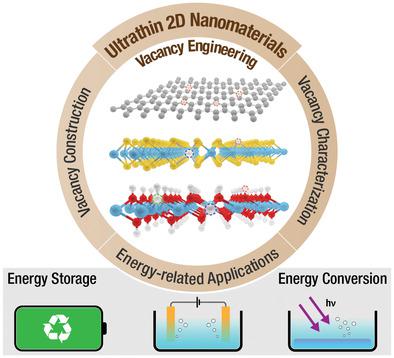当前位置:
X-MOL 学术
›
Adv. Energy Mater.
›
论文详情
Our official English website, www.x-mol.net, welcomes your
feedback! (Note: you will need to create a separate account there.)
Vacancy in Ultrathin 2D Nanomaterials toward Sustainable Energy Application
Advanced Energy Materials ( IF 24.4 ) Pub Date : 2019-11-04 , DOI: 10.1002/aenm.201902107 Fan Bai 1 , Liang Xu 1 , Xiaoying Zhai 1 , Xu Chen 1 , Wensheng Yang 1
Advanced Energy Materials ( IF 24.4 ) Pub Date : 2019-11-04 , DOI: 10.1002/aenm.201902107 Fan Bai 1 , Liang Xu 1 , Xiaoying Zhai 1 , Xu Chen 1 , Wensheng Yang 1
Affiliation

|
The unique physicochemical properties of (2D) nanomaterials make them well‐suited for use in sustainable energy applications. Many of these materials can be further improved with vacancy engineering. This review details recent progress in the vacancy engineering of ultrathin 2D nanomaterials. For clarity, it mainly focuses on various ultrathin 2D materials in three categories: Xa&XaYb‐, MaXb‐, or MaXbYc‐structured materials. Recently developed vacancies in different types of ultrathin 2D materials, as well as their preparation and characterization, are described. Emphasis is placed on the potential electrochemical energy storage and conversion applications of these materials. This review considers the relationship between vacancy properties and material categories of various ultrathin 2D materials in terms of application requirements, preparation, and characterization techniques. The challenges and future outlook of this promising field are summarized.
中文翻译:

超薄二维纳米材料中的空缺,以实现可持续能源应用
(2D)纳米材料的独特理化特性使其非常适合用于可持续能源应用。这些材料中的许多材料都可以通过空缺工程得到进一步改善。这篇评论详细介绍了超薄2D纳米材料的空缺工程方面的最新进展。为了清楚起见,它主要关注三种类别的各种超薄2D材料:X a&X a Y b ‐,M a X b ‐或M a X b Y c结构化材料。描述了不同类型的超薄2D材料中最近开发的空位,以及它们的制备和表征。重点放在这些材料的潜在电化学能量存储和转化应用上。这篇综述从应用需求,制备和表征技术的角度考虑了空位特性与各种超薄2D材料的材料类别之间的关系。总结了这个有前途的领域的挑战和未来前景。
更新日期:2020-03-19
中文翻译:

超薄二维纳米材料中的空缺,以实现可持续能源应用
(2D)纳米材料的独特理化特性使其非常适合用于可持续能源应用。这些材料中的许多材料都可以通过空缺工程得到进一步改善。这篇评论详细介绍了超薄2D纳米材料的空缺工程方面的最新进展。为了清楚起见,它主要关注三种类别的各种超薄2D材料:X a&X a Y b ‐,M a X b ‐或M a X b Y c结构化材料。描述了不同类型的超薄2D材料中最近开发的空位,以及它们的制备和表征。重点放在这些材料的潜在电化学能量存储和转化应用上。这篇综述从应用需求,制备和表征技术的角度考虑了空位特性与各种超薄2D材料的材料类别之间的关系。总结了这个有前途的领域的挑战和未来前景。











































 京公网安备 11010802027423号
京公网安备 11010802027423号